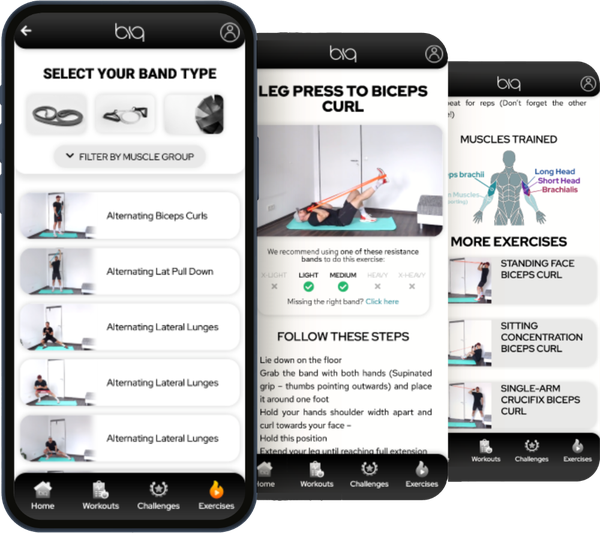Every complete back workout routine should consist out of horizontal and vertical pulling movements. Our backs consist out of quite a lot of different muscles, and this approach will ensure that all of them are trained sufficiently. The lat pulldown is the go-to exercise for your vertical pulling. And you can do them very effectively by using resistance bands.
You will need two things to get started with your next back workout. First a resistance band and second a door anchor. You have to attach the resistance band to a point above your head for it to be effective. When it comes to resistance bands, we highly recommend you get a set of band instead of a single one. A set will contain resistance bands with different resistance levels. Therefore, you will be able to adjust the resistance and do all the exercises for other body parts. If you still don’t have a set, grab our Resistance Bands Set and start making progress. While you are at it get yourself a Door Anchor as well.
This article will teach you how to do a perfect lat pulldown with resistance bands. You will find a step-by-step description as well as a how-to video. Furthermore, we will cover variations for the lat pulldown as well as different methods to adjust the resistance. In the last section you will find background information about effectivity of resistance band training, what muscles you will use in this exercise and how to effectively incorporate lat pulldowns into your workout.
How To Do Lat Pulldowns The Right Way With Resistance Bands?
STOP! I know you wanted to go straight into doing the exercise…don’t deny it! Please promise us to warm up every time you do any heavy resistance work. This way you will benefit by having a better workout, steady progress and minimal chance of having an injury.
You will be needing a resistance band and something to attach it to. The easiest way is using a door anchor, but you can also attach it to a pull-up bar or anything else which is stable and has a sufficient height. We also recommend getting gloves when you use resistance bands. This will ensure your skin doesn’t have to experience the friction of the band. These Workout Gloves are great!
The 6 steps that will give you the perfect Lat Pulldown:
- Attach the band to the top of a door with a door anchor
- Step back until there is tension on the resistance band
- Bend over with your upper body and align with the band path (Bend your knees for more stability)
- Pull towards your chest – neutral grip
- Return slowly to the starting position (resist against the pull of the band)
- Repeat for reps
Common Form Mistakes
⓵ No Slack! – No tension in the band means no resistance, and this means that your muscles are not working. We don’t want that. To avoid this mistake, move away from the anchor point until the band has tension in the starting position and is already puling you towards the anchor point.
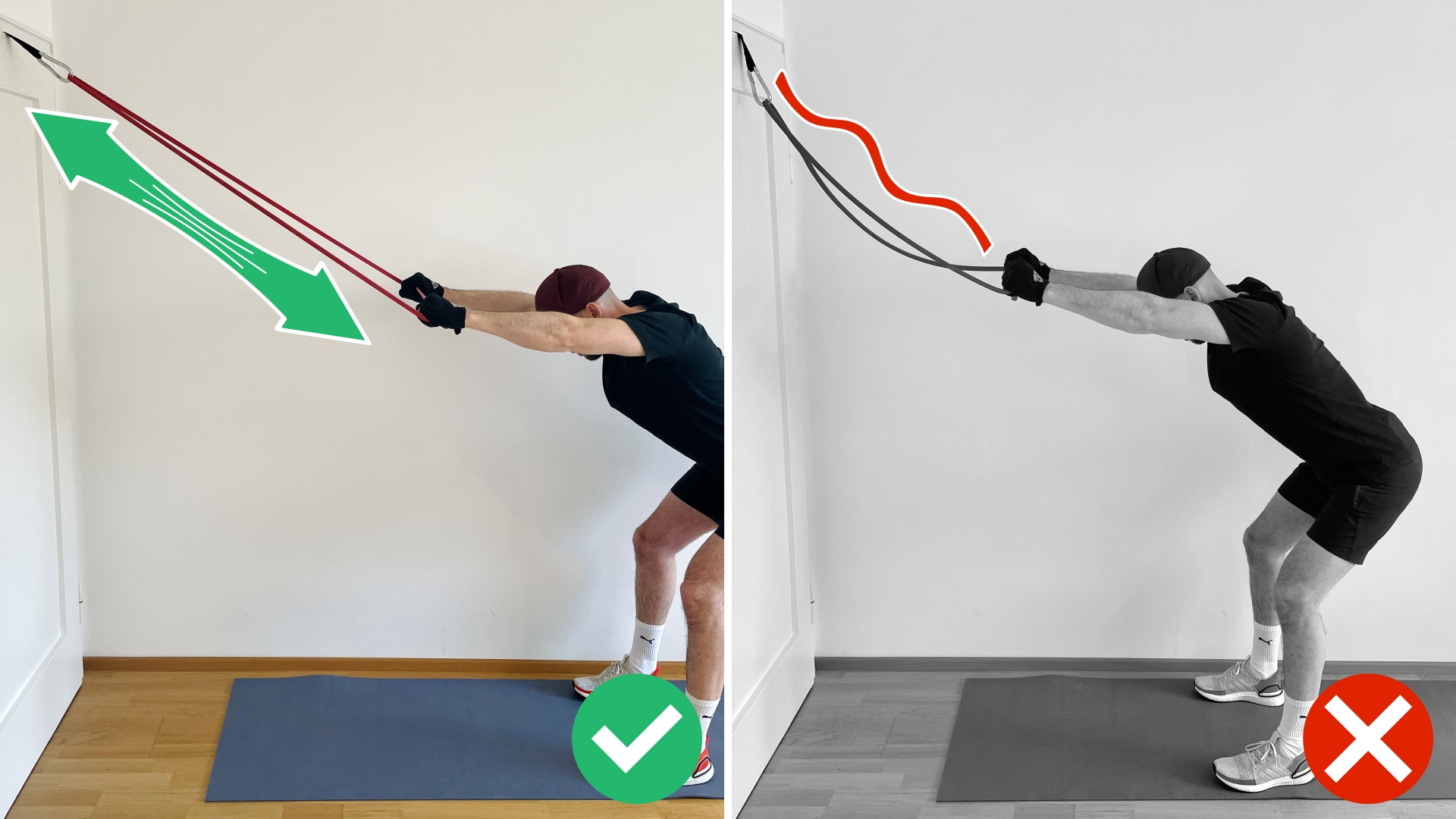
⓶ Straight Back and externally rotated shoulders! – Many beginners have some level of this form-mistake. Rounding your back is never a good idea while doing resistance training. It increases the chance of injury to your lower back, and in addition you are much weaker in this position. Keep your back straight and the neck aligned with the upper body.
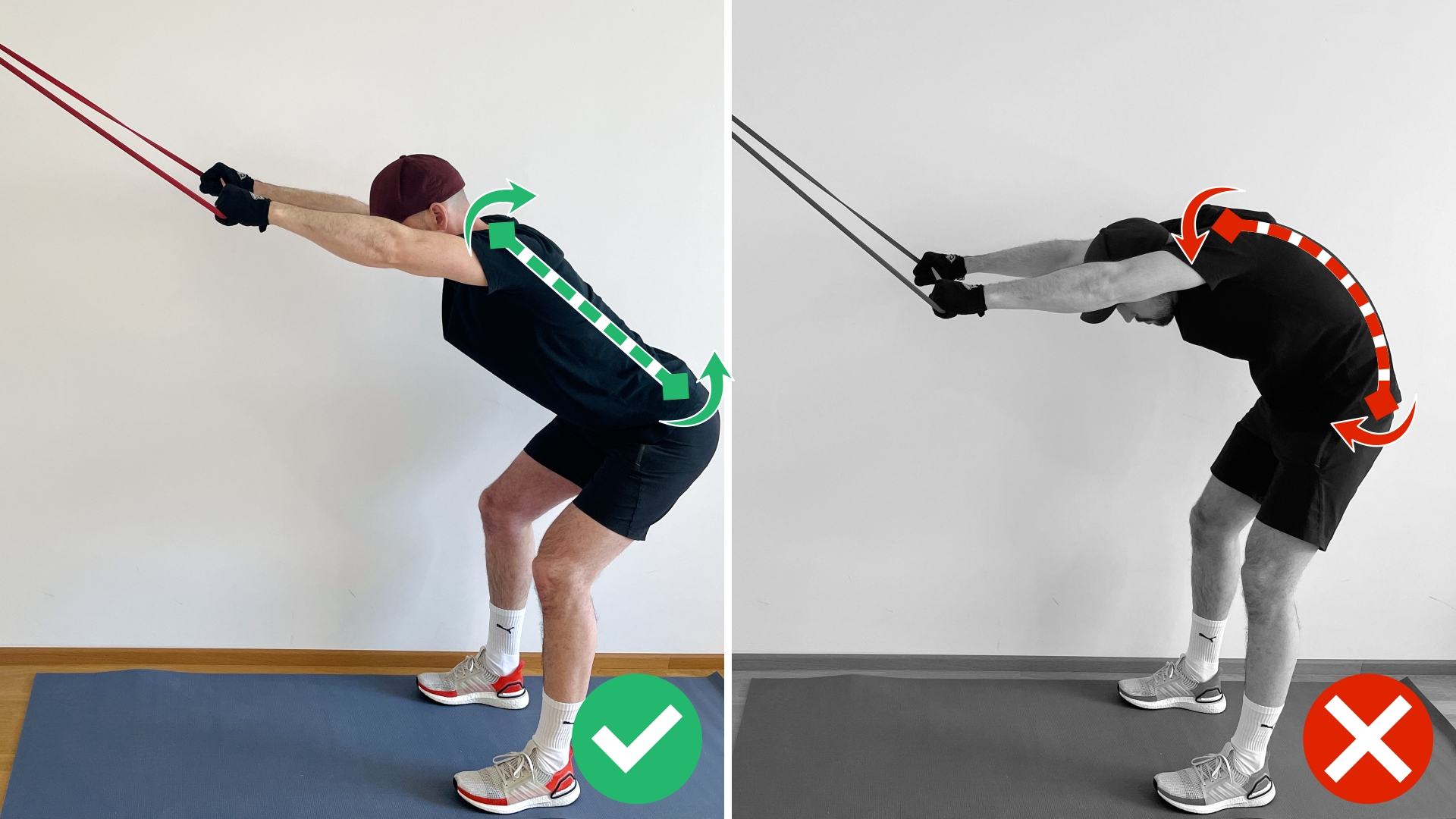
What often comes along with a rounded back is internally rotated shoulders. This completely changes the path of movement and your back muscles won’t be trained effectively. Rotate your shoulders back and stick your chest out.

⓷ Control Each Repetition! – in any resistance exercise, the negative movement (the eccentric part of the exercise) is where you will really make progress. So don’t let the band simply snap back – actively resist the pull of the band and slow down your negatives.
Avoiding these mistakes will give you a perfect lat pulldown and keep you injury free.
To get the effectivity of resistance band training even higher, you should know and avoid the most common mistakes a lot of people do. We collected all of them: The Worst Mistakes You Can Do When Training With Resistance Bands
How To Adjust The Resistance
Compared to weights, a resistance band does not have a fixed resistance. Each band has a range depending on how far you stretch the band. Due to the linear variable resistance of resistance bands, the further you stretch a band the more it will want to go back to it’s relaxed state, and therefore you will have to work against more resistance.
Lots of people don’t use the full potential of a given resistance band and jump straight to the next heavier one once the exercise gets a little easier. You wouldn’t jump from 10 kg straight to 20 kg when training with weights once 10 kg becomes easier. Therefore, we need to know how we can adjust the resistance of a given band to get more resistance out of it.
The best methods to adjust the resistance for lat pulldowns are:
Changing the Distance to Anchor point –This is my go-to method. By simply taking a step backwards, you will have a greater stretch of the band in the starting position and therefore a higher resistance to work against. What I like about this approach the most is, that you can also take a step forward to lower the resistance. This is especially great to get a couple of extra reps in at the end of a set when your muscles start to fatigue.
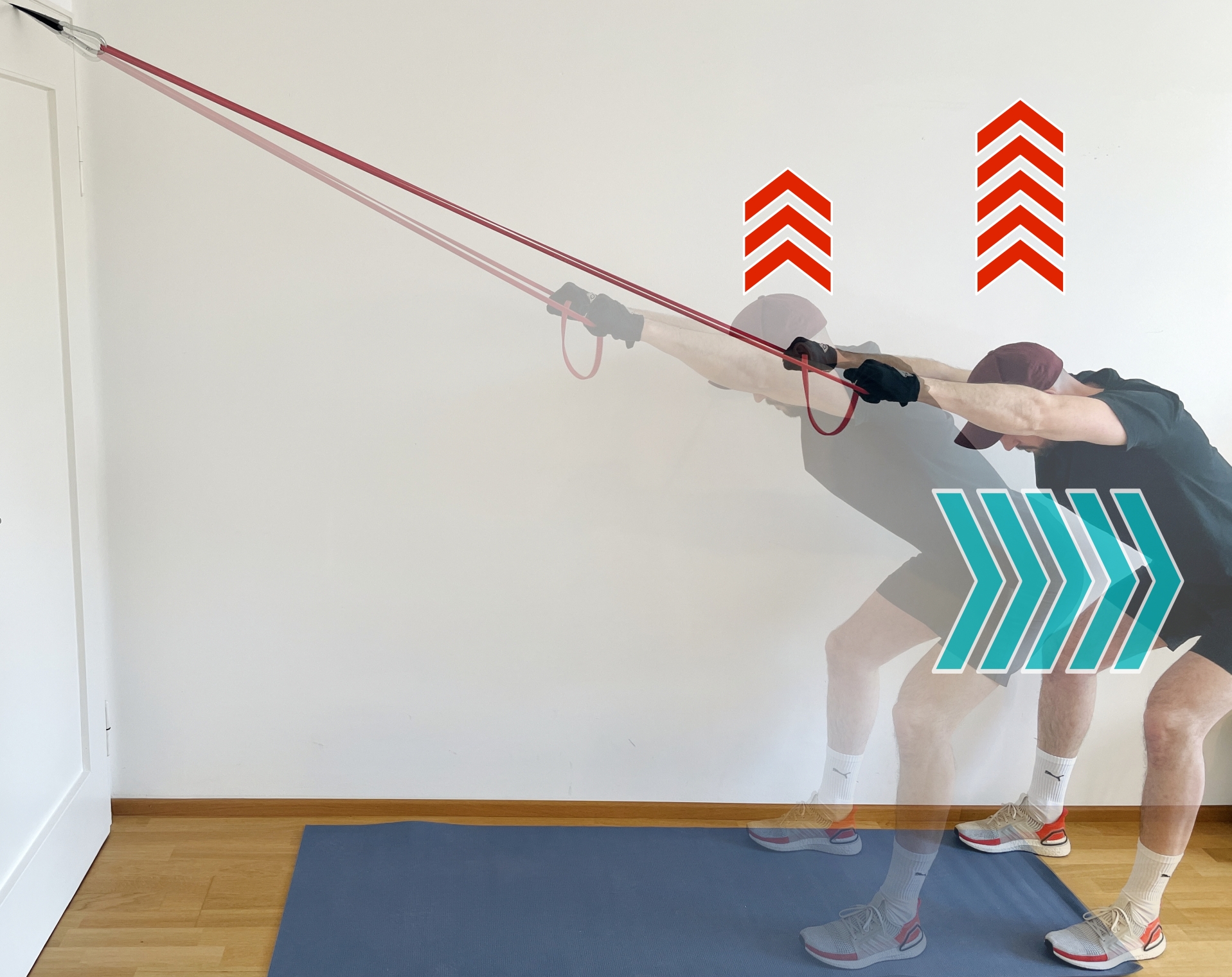
Adjusting the length of the band – If you only have limited space available and simply can’t move further away from the anchor point, this is the way to increase the resistance. Grab the band further towards the anchor point to increase the tension throughout the movement. To have it really secure in my hand, I like to wrap the band around my palm.
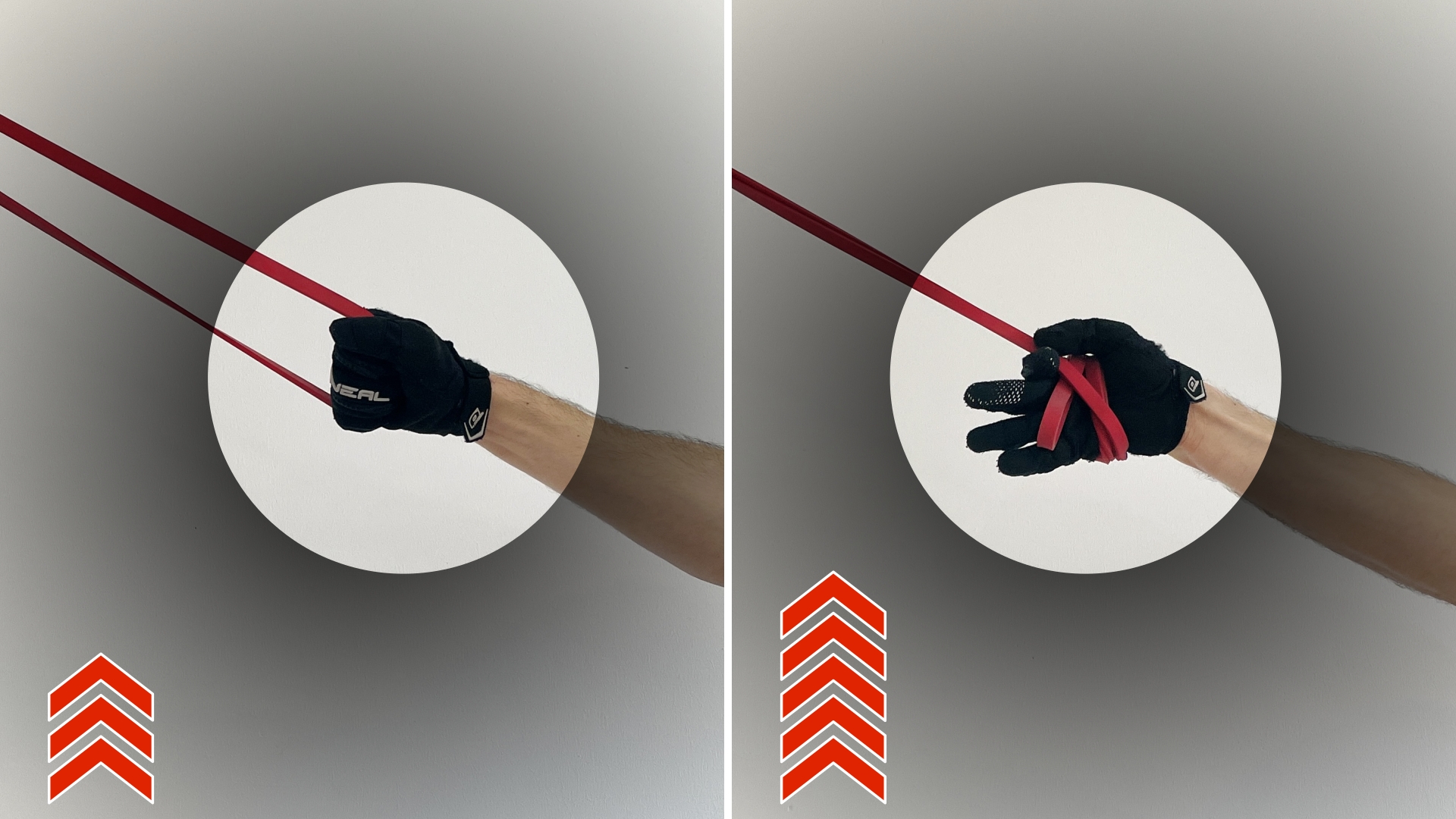
Combining bands – You did get yourself a set of resistance bands, right? Having a set enables you to combine bands to get the right resistance. What I like to do is adding the lightest band to the exercise once I feel it gets easier to get my reps in.
Slowing it down – There are always 2 methods to increase intensity for a given exercise. Adding resistance or adding total time under tension. By slowing down your reps, you will force your muscles to work harder without changing the resistance.
Combining Methods – This one often gets forgotten. You can combine methods to get the right resistance for your goals. Add a light band and make them shorter, or slow down your reps and take an additional step backwards. Unlimited possibilities.
The BIQ App
Take training with resistance bands to the next level with our free app.
- 800+ Exercises
- all band types
- different training goals & workouts
- challenges
- much more
Alternative Ways To Do Lat Pulldowns With Resistance Bands
Depending on your set-up, you might like the following variations better than the version we showed above. These are also great if you just want to change it up and do an unfamiliar exercise variation.
Floor Lat Pulls – this variation is great if you just can’t find an anchor point which is high enough. A great thing about this alternative version is that it will ensure a good exercise form. You won’t be able to round your back or internally rotate your shoulder while lying on the floor. You might need to use a yoga mat to prevent slipping on the floor.

How to do it:
- Attach the band to a door anchor at floor level
- Grab the band with both hands, lie down in the floor and move back until there is no slack in the band, and you feel it pulling at your arms
- Now pull back – think about bringing your elbows to the side of your body
- Return slowly to the starting position (resist against the pull of the band)
- Repeat for reps
Unilateral Lat Pulldown – doing your lat pulldowns unilaterally is a great idea if you really want to focus on one side at a time and build that mind muscle connection. Also, if you want to eliminate any disbalances between the left and the right side.
Another reason for switching to the unilateral variation is your absolute strength. Your back is very strong, and you will be able to handle quite some resistance. Since we can’t lock our body in space, there might come a level where you will pull yourself towards the door instead of the band towards you. This is a good time to switch to unilateral work.
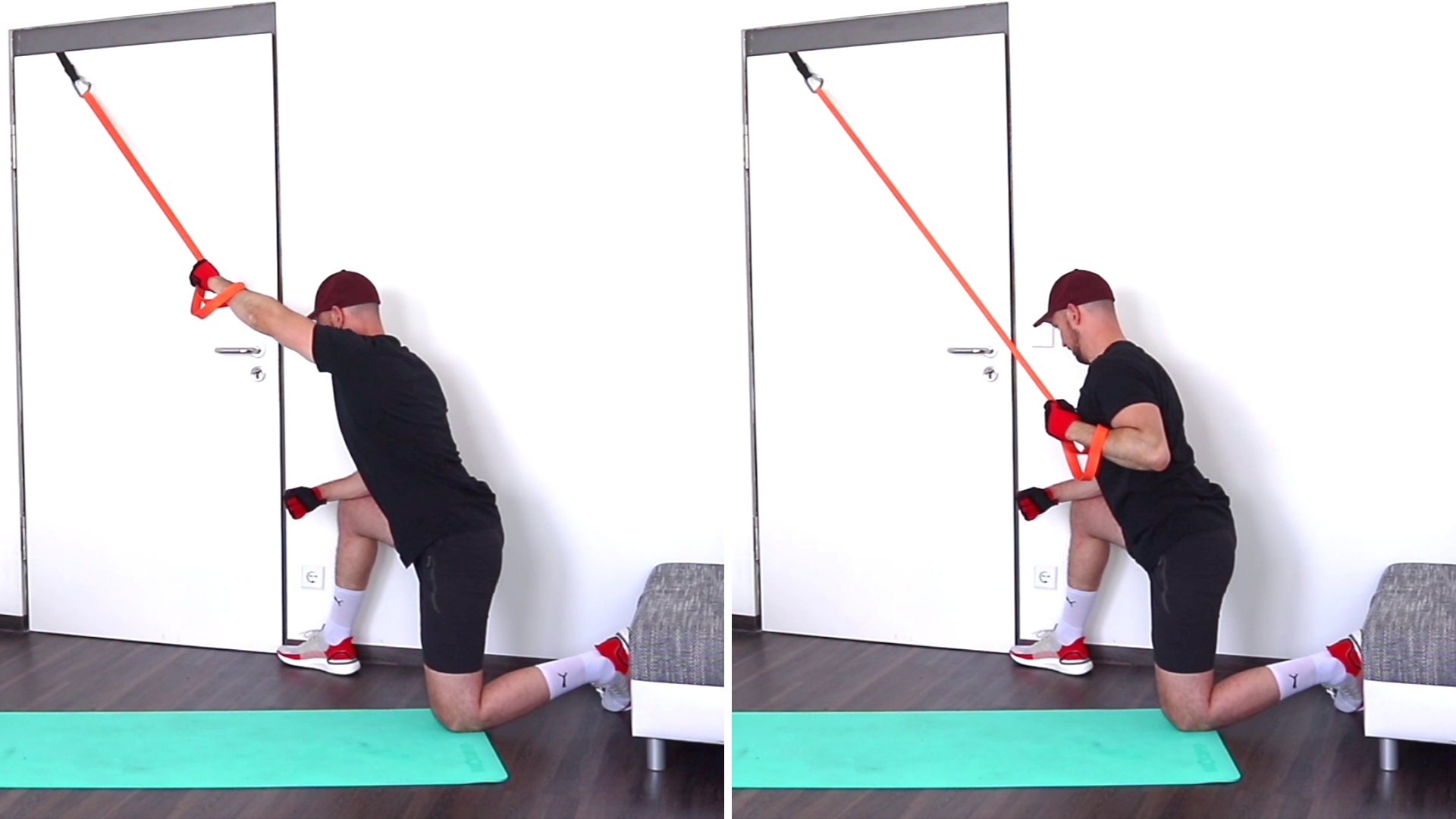
Can You Train Your Back Effectively With Resistance Bands?
To make it short: YES!
Resistance bands are a great tool to generate resistance and stimulate your back muscles. Everybody who tells you otherwise never gave resistance bands a chance or used them incorrectly. Resistance bands are far from being only useful for warming up and mobility work. They can generate as much resistance as weights can and have even advantages over working out with weights (keep reading to find out more).
Why Does Training With Resistance Bands Work
The answer is pretty simple. When we do resistance training, our body doesn’t know the difference between weights and bands. The only thing your muscle thinks is “There is resistance and I have to work against that!”. This “working against a resistance” is what gives your muscles a stimulus to grow and builds strength. So there is no difference for our bodies if the resistance comes from weight in combination with gravity or the tension of a resistance band.
If you want to learn more about this topic – read our full article: Why Does Training With Resistance Bands Work
Benefits Of Training With Resistance Bands
We promised you benefits that resistance bands have over weights and machines:
- No Cheating! You won’t be able to cheat your reps with resistance bands by using momentum. With weights and machines, this is a big problem a lot of people have, and it leads to form breakdown and injury.
- Joint Health! Using resistance bands benefits your joints and tendons as well. Working out with weights only can lead to injuries by over stressing joints and tendons.
- Mobile! You can’t bring your home gym on a holiday or business trip. Resistance bands are lightweight and small. You can fit them in any suitcase or backpack and workout anywhere at anytime.
- Affordable! Band are very cheap compared to a gym membership or equipment you need to get for a home gym.
Check out all the benefits of resistance band in this article: Benefits Of Resistance Band Training
What Muscles Are Used In A Resistance Band Lat Pulldown
The two main pulling muscles in your upper body are the Traps and the Lats. In the Lat pulldown we target primarily the lats. They will do most of the work in this movement. The traps will also be activated – but to a lower degree. The biceps will be heavily involved and has to work quite hard throughout the movement as well.
Main Working Muscles:
- Latissimus dorsi
- Biceps brachii
Secondary Muscles Working:
- Trapezius
- Posterior Deltoids
- Core muscles (not in the muscle map)
Workout Plan
Lat pulldowns alone are not enough to build a great back, and far from a balanced workout for your full body. But drafting your own workout routine is a hustle and needs a basic understanding of workout principles. Especially as a beginner, you simply don’t have all that knowledge.
In addition, there is so much information (and misinformation) out there that it is really hard to know where to start. That’s why we designed an easy-to-use app which helps you with all that. You can simply select your training goal (for example: Build muscle or burn fat), select what kind of bands you have, and we give you a follow along workout routine, including which exercises in which order to do as well as what reps and sets to complete.
You will also have a complete library of all exercises, including a how-to video and a step-by-step guide of how to do it. And a lot of additional features.
Find out more here: BIQ Training App

